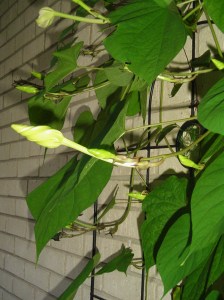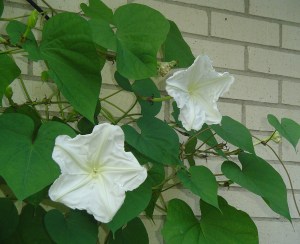If only the internet allowed us to post a fragrance as easily as we post a photo…
Moonflowers, like Gingerlily, fill the garden with an intriguing fragrance. If you enjoy the fragrance of Easter Lily, your memory might lead you to the fragrance of the Moonflower.
 My Moonflowers bloomed last night under the full Harvest Moon.
My Moonflowers bloomed last night under the full Harvest Moon.
A perennial in their native northern South America and Central America, we must replant them each year in Virginia. Impomoea alba is very sensitive to cold, and will wither when touched by the first heavy frost of Autumn. That is why I save their seed each year, and replant each spring.
 They got off to a slow start this season, and I planted them again in June. Moonflowers do best after the summer solstice, when the nights begin getting longer. We enjoyed our first blossoms of the year this week. The buds stay tightly wound until after sunset. The flowers open fully by late evening, and feed moths all night long. To enjoy them you must be out at night with them, or get up very early before the sun touches them fully. The blossoms wither by late morning, their one night of beauty gone forever.
They got off to a slow start this season, and I planted them again in June. Moonflowers do best after the summer solstice, when the nights begin getting longer. We enjoyed our first blossoms of the year this week. The buds stay tightly wound until after sunset. The flowers open fully by late evening, and feed moths all night long. To enjoy them you must be out at night with them, or get up very early before the sun touches them fully. The blossoms wither by late morning, their one night of beauty gone forever.
I’ve never seen Moonflower vines for sale in a nursery. They are considered night blooming morning glories, and are usually started from seed. Their seeds are large and hard like a chick pea. To speed them along, lay them in the folds of a paper towel, moisten the towel, and zip them into a plastic bag. Keep the bag of seeds in a warm place. After several days the seeds will wake up and eventually sprout. Once the seed coat has opened and a sprout appeared, plant the Moonflower seed in a large pot or prepared bed, an inch or so deep, where you want them to grow for the season. Water and provide a sturdy support. These vines grow very quickly, branch prolifically, and can grow 20′ or more in a single season. In their native tropical home, they will grow to 30′ or more.
The large seeds dry in the pod left from each flower. Once dry, I harvest the seeds to save for next year and share with friends. This is an easy plant to pass along, and such a joy to grow.
Photos by Woodland Gnome
Related articles
- Moonflower (msashleyphoenix.wordpress.com)
- Collect your own seeds for next year’s planting (aurorasentinel.com)
- Day 226: Something Beautiful – The Nocturnal Moon Flower (mtmuchmore.wordpress.com)
- Pentagonal Flowers


